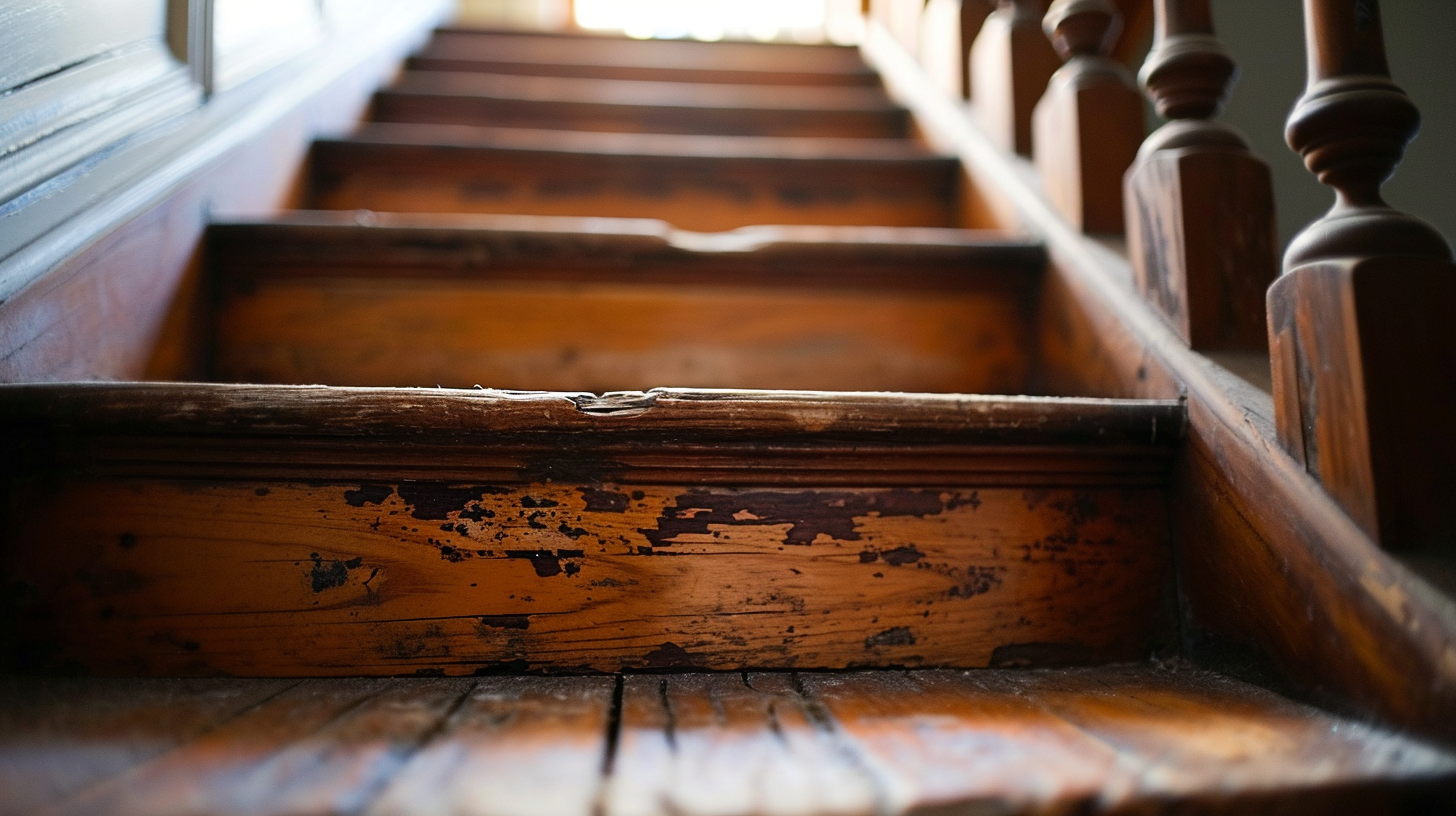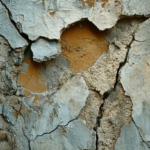Last Updated on 26th December 2023
If you have ever experienced a creaky staircase, you know how annoying and potentially hazardous it can be. In this article, we will guide you through the process of repairing a creaky staircase in a professional and efficient manner. From identifying the cause of the creaking to reinforcing the structure, we will provide you with step-by-step instructions and valuable tips to ensure a safe and silent staircase. Say goodbye to those irritating creaks and hello to a sturdy and quiet staircase.
Identifying the Cause of the Creaking
During our investigation, we will systematically examine the staircase components in order to pinpoint and resolve the underlying issue causing the creaking. Creaking staircases can be caused by a variety of factors, including loose or damaged treads, worn-out subflooring, or inadequate support structures. Loose treads can create movement and friction between the stairs and the surrounding framework, resulting in the creaking sound. Similarly, worn-out subflooring can cause the staircase to become unstable and produce unwanted noise. To prevent creaking, proper installation and maintenance are essential. Regularly inspecting and tightening loose treads, reinforcing weak subflooring, and ensuring proper support structures are in place can help minimize or eliminate creaking. Additionally, using high-quality materials and following industry standards during construction or renovation can prevent creaking from occurring in the first place.
Assessing the Damage
When it comes to assessing the damage of a creaky staircase, it is important to start by identifying the source of the creak. This involves carefully listening and inspecting each step for any visible signs of wear or damage. Once the source is identified, the next step is to evaluate the overall structural integrity of the staircase to determine how extensive the damage may be. Finally, based on the assessment, the appropriate repair techniques can be determined to effectively address the creaking issue.
Identifying the Creak Source
The homeowner’s keen observation and careful examination revealed the source of the creak, allowing for an accurate assessment of the damage. When it comes to creaky staircases, identifying the common causes is essential to prevent future creaking. The most common cause of creaking stairs is loose or damaged stair treads. Over time, the constant pressure and foot traffic can cause the treads to become loose or develop cracks, resulting in annoying creaks. Another common cause is inadequate support underneath the staircase. Insufficiently secured or worn-out joists can lead to sagging steps and creaking noises. Additionally, improper installation or loose handrails can also contribute to the problem. To prevent future creaking, it is crucial to address these issues promptly. Regular inspections, tightening loose components, and ensuring proper support can help maintain a quiet and safe staircase environment.
Evaluating Structural Integrity
To accurately assess the damage caused by a creaky staircase, it is imperative to thoroughly evaluate the structural integrity of the stair treads and underlying support system. When evaluating safety hazards, conducting a visual inspection is essential. Start by examining the stair treads for signs of wear and tear, such as cracks, splintering, or sagging. Check the underlying support system, including the stringers and joists, for any signs of damage or instability. Look for signs of rot, insect infestation, or water damage, as these can compromise the structural integrity of the staircase. Additionally, pay attention to any loose or missing screws or nails, as these can also contribute to creaking and instability. By conducting a thorough visual inspection, you can accurately identify the extent of the damage and determine the necessary repairs to ensure the safety of the staircase.
Determining Repair Techniques
In order to effectively determine repair techniques, it is necessary to thoroughly assess the extent of the damage and consider the most appropriate solutions. When it comes to repairing cracks and strengthening support, a careful evaluation is crucial. Cracks in structures can occur due to various reasons such as age, weather conditions, or structural issues. Before implementing any repair technique, it is important to identify the root cause of the crack and evaluate its severity. This assessment will help determine the most suitable repair method, whether it involves patching the crack, injecting epoxy to stabilize it, or reinforcing the structure with additional support. Strengthening support may involve installing additional beams, braces, or reinforcing bars to enhance the structural integrity. By thoroughly assessing the damage and considering the appropriate repair techniques, a long-lasting and effective solution can be achieved.
Gathering the Necessary Tools and Materials
Acquiring the essential tools and materials is imperative for efficiently addressing the issue of a creaky staircase and ensuring a successful repair. When it comes to selecting appropriate materials, it is essential to consider the specific needs of the staircase. This includes choosing the appropriate type of wood for any necessary replacement steps or supports, as well as selecting the right screws or nails for securing the components together. Additionally, it is crucial to gather the necessary tools such as a hammer, drill, level, and measuring tape to accurately measure and install the materials. By using high-quality materials and tools, the repair will not only fix the creaky staircase but also prevent future damage. This proactive approach will ensure a durable and long-lasting solution.
Fixing Loose or Damaged Steps
Our team should promptly address any loose or damaged steps to maintain the safety and functionality of the staircase. Fixing cracked steps is an essential part of staircase maintenance. Cracked steps not only compromise the structural integrity of the staircase but also pose a safety hazard to users. These cracks can occur due to various factors such as age, wear and tear, or improper installation. When fixing cracked steps, it is important to assess the severity of the crack and determine the appropriate repair method. This may involve filling the crack with epoxy, using wood glue or adhesive, or in some cases, replacing the entire step. Additionally, replacing broken balusters is another crucial step in maintaining a safe and sturdy staircase. Balusters, also known as spindles, provide support and prevent falls. Any broken or missing balusters should be replaced promptly to ensure the safety of stair users. Regular inspection and maintenance of the staircase will help identify any loose or damaged steps or balusters and allow for timely repairs.
Repairing Loose or Worn-out Nails or Screws
When repairing loose or worn-out nails or screws in a staircase, it is important to carefully inspect the area to identify any loose nails that need to be tightened or replaced. Additionally, worn-out screws should be removed and replaced with new ones to ensure stability. Finally, securing the loose staircase by reinforcing it with additional screws or nails can help prevent further damage and ensure the safety of those using the stairs.
Finding Loose Nails
How can we efficiently identify the locations of any loose nails in the staircase for quick repair? Finding hidden damage in a staircase can be a challenging task, but it is crucial for maintaining the safety and integrity of the structure. One of the key factors in identifying loose nails is proper nail tightening techniques. When nails are not properly tightened during installation or have become loose over time, they can cause creaking and instability in the staircase. To efficiently locate loose nails, it is important to carefully inspect each step, paying close attention to any signs of movement or unusual sounds. Additionally, using a nail punch tool to tap along the edges of the steps can help identify loose nails by producing a distinct sound. Once the loose nails are identified, they can be tightened or replaced to ensure a sturdy and safe staircase.
Replacing Worn-Out Screws
To effectively address the issue of replacing worn-out screws, it is essential to carefully assess the condition of the screws and determine the appropriate size and type of replacement screws needed for the specific staircase repair. Worn-out screws can lead to loose or creaky stairs, compromising the safety and stability of the staircase. When assessing the screws, it is important to check for signs of stripped threads, which can occur when the threads wear down or become damaged over time. If the threads are stripped, simply replacing the screw may not be sufficient. In such cases, using wood glue for reinforcement can be a viable solution. Applying wood glue to the screw holes before inserting the replacement screws can provide added strength and stability, ensuring a long-lasting repair.
Securing Loose Staircase
In order to secure a loose staircase, it is crucial to identify the underlying cause of the issue and implement a suitable repair method, such as reinforcing worn-out nails or screws with additional ones. This will not only fix the immediate problem but also prevent future creaking and ensure the safety of anyone using the staircase. However, it is important to note that repairing a loose staircase can be a complex task that requires professional expertise. Hiring professional staircase repair services is highly recommended, as they have the knowledge and experience to accurately assess the situation and provide the most effective solution. They can also ensure that the repairs are done properly, using high-quality materials and techniques that will withstand regular use. By investing in professional repairs, you can have peace of mind knowing that your staircase is secure and will last for years to come.
Reinforcing the Staircase Structure
While reinforcing the staircase structure, it is important to consider the materials and techniques that will provide long-lasting support and stability. Strengthening support and reinforcing the structure of a staircase is crucial to ensure the safety and durability of the stairs. One effective method is to use high-quality materials such as solid wood or metal for the steps and the supporting beams. These materials offer superior strength and resistance to wear and tear. Additionally, techniques like adding additional support brackets or installing steel rods within the staircase can further enhance its stability. Regular maintenance and inspection of the staircase are also essential to identify any potential weak points and address them promptly. By prioritizing the choice of materials and implementing appropriate techniques, the staircase can be reinforced to withstand heavy usage and provide a safe and stable means of accessing different levels of a building.
Dealing With Squeaky Treads or Risers
Efficiently addressing squeaky treads or risers is crucial to ensure a noise-free and comfortable staircase experience for users. Fixing squeaky stairs requires identifying the source of the noise and taking appropriate measures to eliminate it. One common method is to tighten loose screws or nails that connect the treads or risers to the stringers. Applying a lubricant, such as powdered graphite or talcum powder, can also help reduce friction and eliminate squeaks. In some cases, adding shims or wedges between the treads and stringers may be necessary to eliminate gaps and prevent future creaking. Additionally, reinforcing the staircase structure can help reduce the occurrence of squeaks by providing better support and stability. Regular maintenance and inspection of the staircase can also help identify and address any potential issues before they become major problems. By taking these steps, homeowners can enjoy a quiet and comfortable staircase for years to come.
Applying Lubrication to Reduce Friction and Noise
To effectively reduce friction and noise, it is essential for homeowners to apply lubrication, such as powdered graphite or talcum powder, to the staircase components. Applying lubrication techniques not only helps to silence a creaky staircase but also prevents future damage. When stairs creak, it is usually due to the rubbing of wood against wood or metal, causing friction and noise. By applying a lubricant, the friction is reduced, resulting in a smoother and quieter staircase. Powdered graphite or talcum powder are commonly used lubricants for this purpose as they are dry and do not attract dirt or debris. To apply the lubricant, homeowners can simply sprinkle it onto the problem areas, such as the treads and risers, and then work it into the joints. Regular lubrication maintenance can help prolong the lifespan of the staircase and prevent further damage.
Testing and Inspecting the Repaired Staircase
After completing the repair work on the staircase, it is crucial to conduct thorough testing and inspection to ensure the structural integrity and stability of the repaired components. Testing techniques play a vital role in determining the effectiveness of the repairs and identifying any potential issues that may have been overlooked during the repair process. One commonly used testing technique is load testing, where the repaired staircase is subjected to various loads to assess its strength and stability. Additionally, visual inspections should be carried out to check for any visible signs of damage or weakness. It is also important to perform post-repair maintenance to ensure the long-term durability of the staircase. This may include regular inspections, cleaning, and maintenance of any protective coatings or finishes applied during the repair process. By conducting thorough testing and implementing post-repair maintenance, the repaired staircase can be confidently deemed safe and reliable for use.




